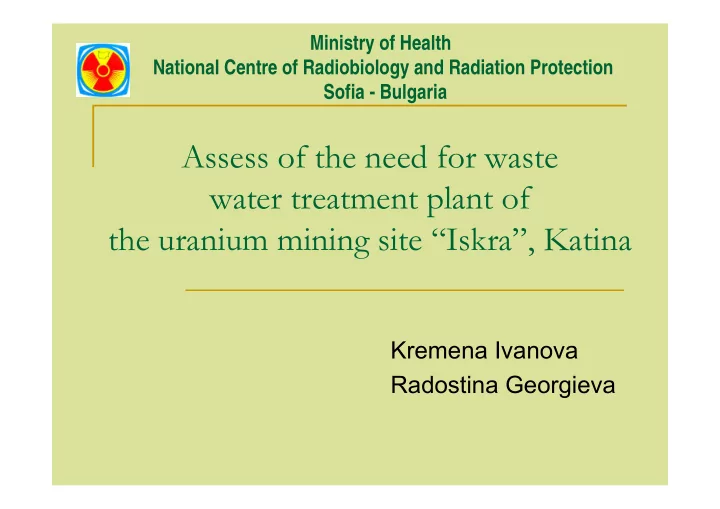

Ministry of Health National Centre of Radiobiology and Radiation Protection Sofia - Bulgaria Assess of the need for waste water treatment plant of the uranium mining site “Iskra”, Katina Kremena Ivanova Radostina Georgieva
SITE DESCRIPTION Uranium mining area "Iskra" is located in west “Stara Planina”mountain , next to the village of Katina and city Novi Iskar about 15 km north of Sofia.
SITE DESCRIPTION
SITE DESCRIPTION � Area "Iskra" is located in the catchment of the river “Taina”, which is left affluent of the River Iskar. � Total area is approximately 4 km 2 and long 1.2 kilometers. � Moderate continental climate, bordering the mountain area. ( There are cold winters with average January temperatures below 0 ° C and a long and hot summers with average July temperatures around 20 °C typically).
SITE DESCRIPTION � Precipitation in the area have a clearly expressed maximum principal in spring - summer season (May - June) and the main minimum in winter (February) � Average annual rainfall is in the range 640 - 700 mm � The prevailing wind direction during the year is from the west. � Area of Katina village is approximately 20.527km 2 with a population of about 931 citizens
OPERATION HISTORY � 1956 - The development of the deposit began through open-pit mining of peak “Brezy brah” Simultaneously trace the horizontal facilities in lower horizons. � 1962 – Classic mining shut down due to depletion of stocks � 1982 – Reassessment of stocks was made � 1985 - In situ leaching technology was organized
ACTUAL SITUATION � 1992 – Closing of the Uranium mining � 2000 – Technical liquidation was completed. It consisting of: Above-ground facilities � Dismantling the equipments � Demolishing the buildings � Decontamination � Depositing the radioactive waste Underground facilities � Closing with two concrete walls
ACTUAL SITUATION � 2005 - The technical remediation was completed. It consist of: � Stabilization and reshaping of the surface � Removing of the surface water � Covering in no radioactive soil layer � Measuring of the gamma dose rate � Calculating the thickness of the layer � Covering in the soil layer � 2008 - The biological remediation was completed. It consist of: � Revegetation � Growing a plants or a bushes
ACTUAL SITUATION � 2005 – The polluted water is purified with sorption column
Pathways of migration
Exposure pathways
MATERIALA AND METHODS Sampling Sampling Description of the Environmental point area components P1 Before SC water P2 After SC water, sediment P3 Gully after SC soil P4 Waste rock pile air P5 Lake “Kiselo” water, sediment P6 100 m. after lake water, sediment P7 River “Taina” water, sediment P8 River “Iskar” water, sediment
Sampling map
MATERIALA AND METHODS Environmental Radiation Methods components parameter air Rn concentration Direct measurement Gamma dose rate water U nat Ra-226, Radiochemistry gross alpha activity Soil, sediment Natural Gamma radionuclides spectrometry
RESULTS – direct measurement Sampling Gamma dose rate Rn concentration point [nSv/h] [Bq/m 3 ] P1 230 ± 30 P2 250 ± 30 P3 230 ± 30 P4 350 ± 40 16 ± 7 P5 200 ± 20 P6 180 ± 20 P7 160 ± 20 P8 160 ± 20
RESULTS – soil and sediment samples Sampling Activity concentration point U nat . 226 Ra 232 Th [mg/kg] [Bq/kg] [Bq/kg] P2 116 ± 8 122 ± 6 15.8 ± 3.4 P3 10.3 ± 2.0 235 ± 11 40.3 ± 3.8 P5 14.5 ± 1.8 165 ± 7 33.9 ± 2.0 P6 16.0 ± 2.8 38.0 ± 2.2 47.3 ± 3.7 P7 9.9 ± 1.6 35.4 ± 1.7 54.4 ± 4.1 P8 5.5 ± 0.8 35.0 ± 1.7 36.2 ± 2.1
RESULTS – water samples Sampling Activity concentration point PH U nat . 226 Ra Gross α [mg/l] [Bq/l] [Bq/l] P1 2.63 0.80 ± 0.08 0.019 10.44 ± 0.13 P2 2.64 0.54 ± 0.07 0.018 7.02 ± 0.13 P5 2.91 0.14 ± 0.02 0.006 1.74 ± 0.15 P6 6.80 0.09 ± 0.02 0.004 ≤ 0.2 P7 8.16 0.08 ± 0.02 0.004 ≤ 0.2 P8 7.62 ≤ 0.02 0.004 ≤ 0.2
Dose assessment – type of assessment (ICRP- Publication 101) TYPE OF ASSESSMENT SITUATION Prospective Retrospective Practice Design of new facility or Dose to the public from past operations or compliance compliance with the dose with dose the dose constraint constraint for an upcoming year for past year Existing Future prolonged exposures Earlier exposures (e.g., after remediation) Emergency Emergency planning Actual impacts after emergency
Dose assessment – type of assessment (ICRP- Publication 101) Existing situations may require prospective assessments or retrospective assessments to determine the implications of proposed actions. The assessment provides the basis for understanding the future consequences if no actions are taken, or for understanding the dose averted if certain actions are implemented.
Dose assessment – type of assessment (ICRP- Publication 101) Deterministic methods which involve the direct multiplication of selected point values of parameters and environmental concentrations: � screening method - very conservative assumptions are made to estimate dose using concentrations of radionuclides at the point of discharge to the environment. � general assessment - involves populations, pathways.
Model for dose assessment
Dose assessment – without sorption column
Dose assessment – with sorption column
Treatment of uncertainties in dose assessment
Conclusion � It is difficult to take a decision using only dose assessment when the doses is low � Need of additional cost assessment on purpose to apply ALARA � Alternative options have to be assessed
Recommend
More recommend